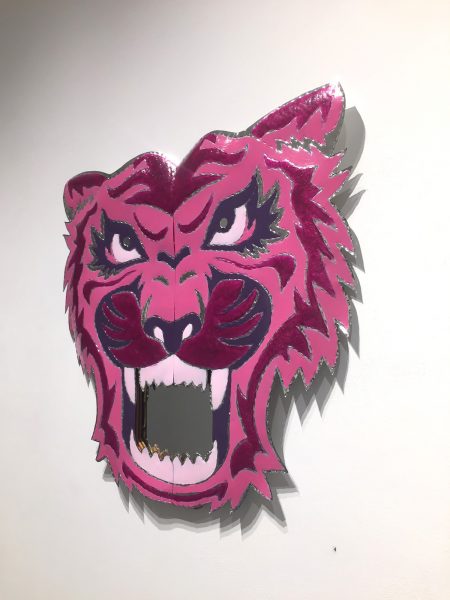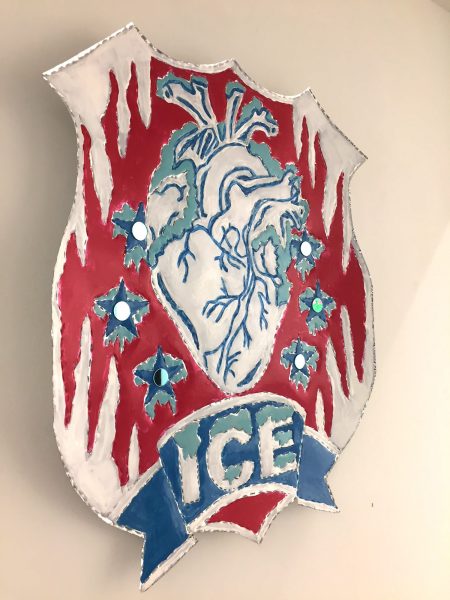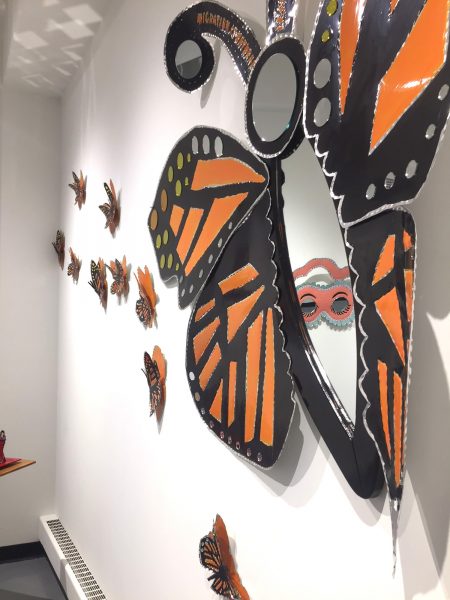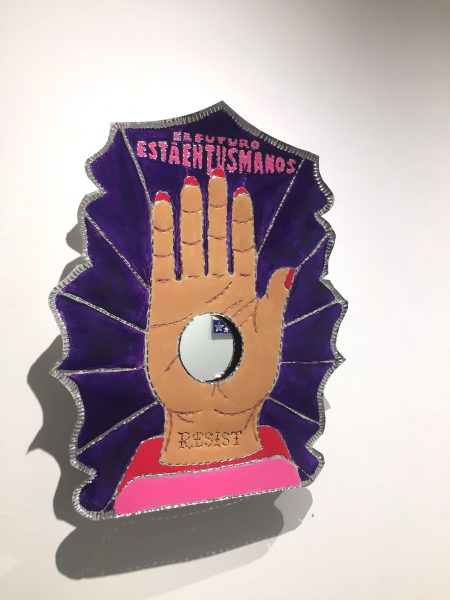Set amidst the hustle and bustle of the back-to-school atmosphere at Thomas More College in suburban Northern Kentucky is a vibrant show of recent work created by Karla Batres Gilvin, a self-described Chicana artist. Batres Gilvin works in the traditional Mexican art form of hojalata, featuring tin, lacquer and mirrors formed into colorful, festive sculptural works of art. But these modern works are more than merely decorative. Instead they carry layers of message and meaning from concept and title through to materials and a high level of craft.
The Eva G. Farris Gallery space is nestled firmly in the middle of academic life at Thomas More College just off the entrance to the campus library. This reviewer visited the show during school hours when classes were shifting and the halls were crowded with students. Upon entering the gallery, the sounds and chaos from outside die away, but visually, that chaos is still present in places within the work due to Batres Gilvin’s copious use of mirrors.
The show’s title is even etched onto a mirror and the viewer is confronted with her own image while reading:
Reflejos- Noun
1: Reflection
“America looked in the mirror and saw her reflection.”
2: Reflex
“America’s response was a reflex of change.”
The word reflejos means reflexes in Spanish. The artist utilizes Spanish in many of her works’ titles and even within the works themselves, flowing between languages to express her concepts, which are strong and indeed, reactive and reflexive to current events.
We live in tumultuous cultural, political and societal times. Batres Gilvin does not shy away from the issues but rather confronts them, from her distinctly Mexican-American perspective, head on. Though most of the works in this show are formed of traditional hojalata artistic materials, the works themselves are not quite traditional in spirit. With pieces such as Girls Can Do Anything (crafted from a found pink stove top and frosted mirrors) to Beware the Pussy (acrylic lacquer on punched tin, mirror- image above), the artist challenges patriarchal mores and channels women’s issues currently at the fore in our society.
Many of the works in the show question current immigration policies set in place by the Trump administration. In the work entitled Pawns In Their Game, a chessboard of lacquered tin pieces portrays children crying as pawns, while those in power – tall and imposing – loom large on the other side of the game. Mirrors create the squares of the chessboard and reflect not only the viewer’s own visage, but imagery of an installation on the wall entitled Migration is Natural, Migration is Beautiful. This piece features monarch butterflies, who traverse the Americas, often taking generations to move from place to place.
There is an inspirational sense of cultural moxie in this collection of work and in the conversations encouraged with the viewer and between the works themselves installed as they are in the gallery setting. Like the hojalata work found in Mexican gift shops, this work is colorful and bright, filled with flowers and cacti, hands and hearts. Within this well crafted bright beauty however is an undercurrent of rebellion. In Viva La Luchadora and Se Habla Español Like It Or Not, the fighting spirit is strong indeed. This powerful collection of works reminds us that we are fighting for the very heart of this country and that, for now, la lucha sigue – (the fight continues) and the future is very much in our own hands.\
–Amy Bogard









